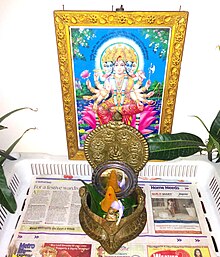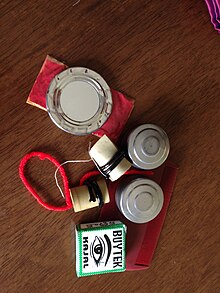Gowri Habba is a Hindu festival celebrated a day before Ganesh Chaturthi.
This festival celebrates the goddess Gowri or Gauri, (also known as Parvati) who is venerated as the mother of Ganesha. It is usually observed by married women and is a significant festival in Karnataka and Tamil Nadu. It is known as Hartalika in the North Indian states of Uttar Pradesh, Bihar, Jharkhand, Rajasthan, Chhattisgarh, Maharashtra and Madhya Pradesh. Gowri, the mother of Ganesha and wife of Shiva, is worshipped throughout India for her ability to bestow upon her devotees courage and power. Hindu belief has it that Gowri is the incarnation of Aadhi Shakthi Mahamaya. She is the Shakthi of Shiva. It is believed that on Thadige, or the third day of the month of Bhaadra, Gowri comes home like any married woman comes to her parents' house. The next day Ganesha, her son, comes as if to take her back to Kailasa.
The Swarna Gowri vratha is performed on the occasion to appease the goddess.[1]
{
On this day, married women, after bathing, wear new or smart clothes and
dress up the girls of the family. Then they do the 'sthapana' of either
jalagauri or arishinadagauri (a symbolic idol of Gowri made of turmeric).
Painted and decorated clay idols of Gowri can be bought at the local
market. The goddess' idol is mounted in a plate, with a cereal (rice or
wheat) in it. As this puja
or ritual is to be performed with 'suchi' (cleanliness) and 'shraddhe'
(dedication), the women go to temples or to another person's house,
where it is performed according to set procedures or they can perform
the ritual in their own homes.
A mantapa, generally decorated with banana stem and mango leaves, is built around the idol. The Gowri is decorated with garlands, decorations made of cotton, and women have a 'gauridaara' (sacred thread with sixteen knots) tied to their right wrists, as blessings of gauri and as part of the vratha. Each of the sixteen knots is worshipped with mantras during the performance of the religious practice[2].[3]
An offering of baagina occurs during the festival. At least five baaginas are prepared as part of the vratha. Each baagina usually contains a packet of arshina (turmeric), kumkum, black bangles, black beads (used in the mangalsutra), a comb, a small mirror, baLe bicchoLe,coconut, blouse piece, dhaanya (cereal), rice, toor dal, green dal, wheat or rava and jaggery cut in a cube form. The baagina is offered in a traditional mora (winnow painted with turmeric). One such baagina is offered to Gowri and set aside. The remaining Gowri baaginas are given to the married women.[1][4]
Another speciality of this festival is that the married woman's
parents and brothers (tavaru maneyavaru) send all items required for
worship[5]
(mangaladravya) to the married daughters of their family. Some send
money as a substitute for mangaladravya. This good practice remains
unchanged and keeps people closer. Newly-married women give sixteen
pairs (jothe) baagina to married women (Sumangalis) and obtain their
blessings. One baagina is kept for the Goddess Gowri (Gowramma). The
main food items in this festival's feast are the delectable "beLe hoLige" / "Kaayee-hoLige", "Huggi" / "Chitranna" and "Bajji" .
{
Newlywed couples are invited to the house of their in-laws and served
with festive food. In the olden days, newly-wed couples had to wait till
Gowri Habba to consummate their marriage.
The logic behind this practice is that if a child is conceived during
Gowri Habba, which falls during the winter, the child would be born nine
months later, during the summer, when it would be less prone to
infections. This practice has been in place for years but has declined
in recent times due to modernisation and wide contraceptive options.
Unmarried girls (kanya) in the house also wear a gauridaara, but it doesn't have knots, just 16 strand cotton thread dipped in turmeric and a yellow chrysanthemum looped in it. These girls must give a variant of baagina to their own sisters, (and optionally to cousins whose mothers perform the Vratha). This childrens' baagina consists of the decorative ornamental items (metal plastic or glass bangles, metal earrings, wearable necklace, in addition to comb, mirror, biccholay) the food items are omitted. This is given along with kumkuma (vermilion), betel leaf, betel nut, and fruit (small fruit other than coconut), and dakshine in small amount (gift money)
This festival celebrates the goddess Gowri or Gauri, (also known as Parvati) who is venerated as the mother of Ganesha. It is usually observed by married women and is a significant festival in Karnataka and Tamil Nadu. It is known as Hartalika in the North Indian states of Uttar Pradesh, Bihar, Jharkhand, Rajasthan, Chhattisgarh, Maharashtra and Madhya Pradesh. Gowri, the mother of Ganesha and wife of Shiva, is worshipped throughout India for her ability to bestow upon her devotees courage and power. Hindu belief has it that Gowri is the incarnation of Aadhi Shakthi Mahamaya. She is the Shakthi of Shiva. It is believed that on Thadige, or the third day of the month of Bhaadra, Gowri comes home like any married woman comes to her parents' house. The next day Ganesha, her son, comes as if to take her back to Kailasa.
The Swarna Gowri vratha is performed on the occasion to appease the goddess.[1]
Swarna Gowri vratha rituals
This section does not cite any sources. (August 2019) (Learn how and when to remove this template message)
|
A mantapa, generally decorated with banana stem and mango leaves, is built around the idol. The Gowri is decorated with garlands, decorations made of cotton, and women have a 'gauridaara' (sacred thread with sixteen knots) tied to their right wrists, as blessings of gauri and as part of the vratha. Each of the sixteen knots is worshipped with mantras during the performance of the religious practice[2].[3]
An offering of baagina occurs during the festival. At least five baaginas are prepared as part of the vratha. Each baagina usually contains a packet of arshina (turmeric), kumkum, black bangles, black beads (used in the mangalsutra), a comb, a small mirror, baLe bicchoLe,coconut, blouse piece, dhaanya (cereal), rice, toor dal, green dal, wheat or rava and jaggery cut in a cube form. The baagina is offered in a traditional mora (winnow painted with turmeric). One such baagina is offered to Gowri and set aside. The remaining Gowri baaginas are given to the married women.[1][4]
Gowri Habba Swarna Gowri
Gowri Habba Swarna Gowri After Puja
Swarna Gowri Vratha
Gowri Baagna Container
Gowri Baagna contents part 1
Gowri Baagna contents part 2
Gowri Baagna contents part 3
Gowri Habba Protocol - Giving Arashina and Kumkuma
Gauri habbada mangaladravya
This section does not cite any sources. (August 2019) (Learn how and when to remove this template message)
|
This article or section needs translation from language to English.
This article or section is written in language. If it is intended for readers from the language language community, it should be contributed to the Wikipedia in that language. See the list of Wikipedias.Please see this article's entry on Pages needing translation into English for discussion. If the article or section is not rewritten in English within the next two weeks it will be listed for deletion and/or moved to the language Wikipedia. |
Customs
This section does not cite any sources. (August 2019) (Learn how and when to remove this template message)
|
Unmarried girls (kanya) in the house also wear a gauridaara, but it doesn't have knots, just 16 strand cotton thread dipped in turmeric and a yellow chrysanthemum looped in it. These girls must give a variant of baagina to their own sisters, (and optionally to cousins whose mothers perform the Vratha). This childrens' baagina consists of the decorative ornamental items (metal plastic or glass bangles, metal earrings, wearable necklace, in addition to comb, mirror, biccholay) the food items are omitted. This is given along with kumkuma (vermilion), betel leaf, betel nut, and fruit (small fruit other than coconut), and dakshine in small amount (gift money)
References
|
|---|








No comments:
Post a Comment